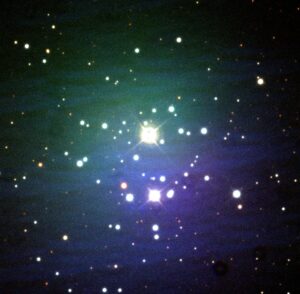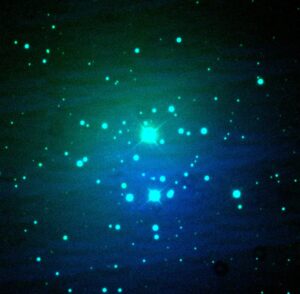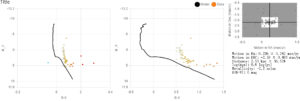NGC 2129 is an open star cluster located in the constellation Gemini. It is a relatively young cluster, estimated to be around 40 million years old, and contains several dozen stars. The cluster is located at a distance of about 3,000 light-years from Earth and has a visual magnitude of 7.2, which means it is visible with binoculars or a small telescope.
NGC 2129 was discovered by the German-British astronomer William Herschel in 1784. The cluster is notable for its relatively high metallicity, which means it contains a higher proportion of elements heavier than helium than many other open clusters.
The stars in NGC 2129 are mainly blue giants and supergiants, with some yellow and orange stars mixed in. It has a diameter of about 16 light-years and is located in a relatively dense region of the Milky Way galaxy. The cluster is surrounded by nebulosity, which makes it a visually striking object in the night sky.
In a recent study in 2021, people determined that the important role of the dislocation of clusters in tracking the external environment of the Milky Way.


In order to study NGC 2129 and investigate the relationships between the colours, brightnesses, and the age and chemical composition of the cluster as a whole. I use the skynet to collect a lot of data with telescopes PROMPT-USASK, Prompt2, and Prompt5, I collected a total of 15 images of NGC 2129 in three different filters (B, V, and R) with a total exposure duration of 55, 30, and 20 seconds in each respective filter. In my analysis, I estimated the motion in RA to be 0.226 ± 0.242 (mas/yr), Motion in DEC to be -2.18 ± 0.483 (mas/yr), Distance to be 2.53kpc ± 56.51%, log (Age) to be 6.6(yr), Metallicity to be -2.2 solar, and E(B-V) to be 0 mag.

There are blue straggler stars in NGC 2129. Blue stragglers are stars that appear to be younger and more massive than the other stars in the cluster, even though they are thought to have formed at the same time. They are believed to form through interactions between binary stars or by merging of stars within the cluster.
An interesting thing is NGC 2129 is surrounded by nebulosity, which makes it a visually striking object in the night sky. The nebulosity is likely a reflection nebula, which occurs when the light from nearby stars is reflected off of nearby gas and dust, giving the nebula a bluish appearance.
Overall, this cluster project was the highlight of my life up to this point. I feel very fulfilled. It can be an exciting and awe-inspiring experience. Astronomy is the study of the universe beyond our planet, and learning about the stars, galaxies, and other celestial objects can be both intellectually stimulating and emotionally moving.
https://fr.wikipedia.org/wiki/NGC_2129
https://fr.wikipedia.org/wiki/William_Herschel
https://in-the-sky.org/data/object.php?id=NGC2129
https://simbad.cds.unistra.fr/simbad/sim-ref?bibcode=2021A%26A…656A..49H